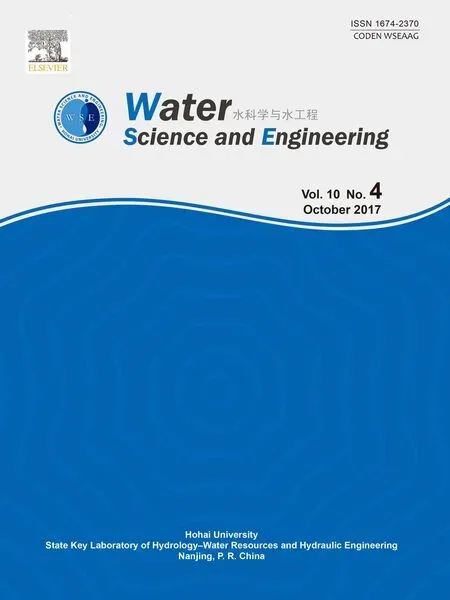Preface for special section on flood modeling and resilience
Jing-ming Hou*,Qiu-hua Liang,Gang Wang,Reinhar Hinkelmann
aInstitute of Water Resources and Hydro-Electric Engineering,Xi'an University of Technology,Xi'an 710048,China
bState Key Laboratory of Hydrology-Water Resources and Hydraulic Engineering,Hohai University,Nanjing 210098,China
cSchool of Engineering,Newcastle University,Newcastle upon Tyne,NE1 7RU,UK
dChair of Water Resources Management and Modeling of Hydrosystems,Technische Universit?t Berlin,Gustav-Meyer-Allee 25,Berlin 13355,Germany
Climate change has led to increased frequency,intensity,and duration of extreme weather events,e.g.,intense rainfall,heat waves,droughts,and storm surges,worsened by rapid population growth and urbanization at the global scale.Evidence can be found in the exceptional number of unprecedented weather extremes and the resulting natural hazards,especiallyflooding,as seen in the last few decades.For example,the UK has experienced numerous storms and severefloods in the last decade,particularly in 2007,2012,and 2015,with 2012 being recorded as the second wettest year in the UK and the wettest ever in England.These events have resulted in lives lost and tremendous economic damage.The UK is not alone.Similarly unusual weather events have been reported across the globe.In China,different types offlooding threaten 1/10 of the country's total area,millions of hectares of farmland,and over 100 large cities,making it one of the most vulnerable countries toflooding.
With increasing pressure from climate change and rapid urbanization,mitigatingflood impacts and boosting resilience againstflooding have become challenges,and important goals,for the governments,stakeholders,and wider communities at different levels in the UK,China,and the rest of the world.Resilience and long-term sustainability of traditional hard engineering solutions toflooding are becoming increasingly questionable when reconciling future increases in risk against the costs of maintaining current levels of protection,among many other shortcomings.There is an urgent need to incorporate moreflexible and adaptable measures(e.g.,by implementing naturalflood management schemes in catchments and developing sponge cities)to improve resilience and reduce the vulnerability of our communities toflooding and other natural hazards.Modeling has become a useful tool for facilitating the management of flood risk and the development of flood resilience strategies.
In view of the challenges and research needs,the Workshop on Catchment Systems Management and Flood Resilience(CSMFR 2015)was held from May 31 to June 5,2015 at Hohai University,in Nanjing,China.Researchers from the UK,China,and other countries attended this workshop to discuss the key research challenges inflood modeling and resilience in both countries and promote research collaboration.Following the workshop,a call for a special section in Water Science and Engineering was issued to welcome submission of papers broadly related toflood modeling and resilience.All of the submissions have gone through the full peer review process as required by the journal.Seven papers are presented in this special section.The main content of the papers is summarized below.
Hou et al.(2017)present a new dynamic Cartesian grid system for inundation modeling using a Godunov-typefinite volume shallow water equation solver.The grid system allows automatic refinement to capture the advancing wet-dry fronts,leading to improved computationalefficiency without compromising solution accuracy.Adopting a different approach to achieve efficient flood modeling,especially in complex urban environments,¨Ozgen et al.(2017)consider porous shallow water equations(PSWEs),which take into account the influence of sub-grid features,e.g.,buildings,on numerical solutions.They analyze the differences in wave propagation speeds of two different formulations of PSWEs,one formulated with a single porosity term(SP model)and the other featuring two porosity terms,known as the integral or anisotropic porosity model(AP model).In the paper by Zhao et al.(2017),two different mathematical models are compared for the simulation of dam breakflow over movable beds.The presented models respectively solve the fully coupled formulation of shallow water equations with erosion and deposition terms(an averaged concentrationflux model),as well as shallow water equations coupled with the Exner equation(bed-load-flux model)using a second-order cell-centeredfinite-volume Godunov-type scheme.Moving to coastal hydrodynamics,Wang et al.(2017)introduce an edge-wave model based on the numerical solution to the extended Boussinesq equations,and use it to investigate the nonlinear properties of standing edge waves.In terms of model application,Lai and Wang(2017)use a hydrodynamic model to predictflood processes and investigate the effects of the fully operating Three Gorges Dam on theflood risk in the middle and lower reaches of the Yangtze River.Yang et al.(2017)investigate the sediment distribution and morphology of the Yellow River Estuary(YRE)following the implementation of the Water-Sediment Regulation(WSR)scheme.This special section is further complemented by Li et al.(2017),who investigate the effect of urban vegetation cover on rainfallrunoff process in the arid areas of China through physical experiments.
Finally,we would like to acknowledge the support provided by Hohai University for holding CSMFR 2015 and sincerely thank all the authors and reviewers for their contributions to this special section.We hope the readers enjoy these papers andfind them useful in their research.
Hou,J.M.,Wang,R.,Jing,H.X.,Zhang,X.,Liang,Q.H.,Di,Y.Y.,2017.An efficient dynamic uniform Cartesian grid system for inundation modeling.WaterSci.Eng.10(4),267-274.https://doi.org/10.1016/j.wse.2017.12.004.
Lai,X.J.,Wang,Z.M.,2017.Flood management of Dongting Lake after operation of Three Gorges Dam.Water Sci.Eng.10(4),303-310.https://doi.org/10.1016/j.wse.2017.12.005.
Li,J.,Li,Z.B.,Guo,M.J.,Li,P.,Cheng,S.D.,2017.Effects of urban grass coverage on rainfall-induced runoff in Xi'an loess region in China.Water Sci.Eng.10(4),320-325.https://doi.org/10.1016/j.wse.2017.12.001.
¨Ozgen,I.,Zhao,J.H.,Liang,D.F.,Hinkelmann,R.,2017.Wave propagation speedsandsourceterminfluencesinsingleandintegralporosityshallowwater equations.WaterSci.Eng.10(4),275-286.https://doi.org/10.1016/j.wse.2017.12.003.
Wang,G.,Sun,Z.B.,Gao,J.L.,Ma,X.Z.,2017.Numerical study of edge waves using extended Boussinesq equations.Water Sci.Eng.10(4),295-302.https://doi.org/10.1016/j.wse.2017.12.002.
Yang,H.B.,Li,E.C.,Zhao,Y.,Liang,Q.H.,2017.Effect of water-sediment regulation and its impact on coastline and suspended sediment concentration in Yellow River Estuary.Water Sci.Eng.10(4),311-319.https://doi.org/10.1016/j.wse.2017.12.009.
Zhao,J.H.,¨Ozgen,I.,Liang,D.F.,Hinkelmann,R.,2017.Comparison of depth-averaged concentration and bed loadflux sediment transport models of dam-breakflow.Water Sci.Eng.10(4),287-294.https://doi.org/10.1016/j.wse.2017.12.006.
 Water Science and Engineering2017年4期
Water Science and Engineering2017年4期
- Water Science and Engineering的其它文章
- Fenton-like oxidation of azo dye in aqueous solution using magnetic Fe3O4-MnO2nanocomposites as catalysts
- Preparation of 2D square-like Bi2S3-BiOCl heterostructures withenhanced visible light-driven photocatalytic performance for dye pollutant degradation
- Effects of urban grass coverage on rainfall-induced runoff in Xi'an loess region in China
- Effect of water-sediment regulation and its impact on coastline and suspended sediment concentration in Yellow River Estuary
- Flood management of Dongting Lake after operation of Three Gorges Dam
- A distributed eco-hydrological model and its application
